Dr.Teruo Higa’s
Living A Dream
- 2025
- Apr:#204 How EM Use Has Spread Throughout the Philippines
- Mar:#203 How to Use EM to Fundamentally Solve the Problem of Agricultural Residue Burning
- Feb:#202 The Spread of EM technology in Germany
- Jan:#201 The 2nd Ichiro Masaki Memorial Universal Village EM International Conference
- Jan:#200 Cleanup of the Ala Wai Canal in Hawaii, where social bonds are strengthened using EM
- 2024
- Nov:#199 EM trials in India with bananas, tomatoes, and pomegranates
- Oct:#198 The Steadily Evolving EM Nature Farming Method at the Blue Sky Palace - Part 8
- Sep:#197 The Steadily Evolving EM Nature Farming Method at the Blue Sky Palace - Part 7
- Aug:#196 The Steadily Evolving EM Nature Farming Method at the Blue Sky Palace - Part 6
- Jul:#195 The Steadily Evolving EM Nature Farming Method at the Blue Sky Palace - Part 5
- Jun:#194 Steadily Evolving EM Nature Farming Method at the Blue Sky Palace - Part 4
- May:#193 Steadily Evolving EM Nature Farming Method at the Blue Sky Palace - Part 3
- May:#192 Steadily Evolving EM Nature Farming Method at the Blue Sky Palace - Part 2
- Apr:#191 Steadily Evolving EM Nature Farming Method at the Blue Sky Palace
- Mar:#190 Quantum Mechanical Effects of EM Gravitron Charcoal
- Mar:#189 The barrier space in Okinawa (Ryukyu Islands) has risen to another dimension
- Jan:#188 Sixty Days after Typhoon No.6
- 2023
- Oct:#187 Supermassive Typhoon No.6 and Subsequent Typhoon No. 11
- Sep:#186 Massive Typhoon No.6 that swallowed the Ryukyu Islands Graviton barrier
- Sep:#185 August 8th is World “EM Mudball Day”
- Aug:#184 A disease-free life depends on the health of the intestinal microbiome.
- Jul:#183 Trial and Error at the Blue-Sky Palace, Part 3
- Jun:#182 Trial and Error at the Blue-Sky Palace, Part 2
- Apr:#181 Trial and Error at the Blue-Sky Palace
- Mar:#180 Ala Wai Canal Cleanup Project in Waikiki, Hawaii
- Feb:#179 High-Yield, High-Quality Rice Production Using EM
- Feb:#178 The Progress the "Soil Preparation Workshop" of the Oishi 3-chan Club (Part 2)
- Jan:#177 Organic Farming Instructional Manual Using EM
- 2022
- Nov:#176 The Typhoon Situation in Okinawa in 2022
- Sep:#175 Third-Party Verification of the Graviton barrier in Okinawa Part-2
- Sep:#174 Third-Party Verification of the Graviton barrier in Okinawa
- Aug:#173 Ecosystem Changes Observed in Okinawa in 2021 Part-5
- Jun:#172 Ecosystem Changes Observed in Okinawa in 2021 Part-4
- May:#171 Ecosystem Changes Observed in Okinawa in 2021 Part-3
- Apr:#170 Ecosystem Changes Observed in Okinawa in 2021 Part-2
- Mar:#169 Koizumi Farm in Kamakura Continues to Evolve
- Feb:#168 Ecosystem Changes Observed in Okinawa in 2021 Part-1
- 2021
- Dec:#167 Enjoying EM Technology While Enriching the Local Ecosystem
- Nov:#166 A Case Study of the Use of EM in a Next Generation Free School in Tune with the Cycles of Nature
- Oct:#165 Typhoon conditions and flowers in Okinawa from August to October
- Sep:#164 Re-learning the origins of river purification using EM Cleaning up the Dairyuji River in Senami (Murakami City, Niigata Prefecture)
- Aug:#163 Measures Against Natural Disasters and Re-learning the Starting Point of EM
- Jul:#162 Summary of FFC (Foods for Children) Okinawa Forum 2021
- Jun:#161 Restoring the Vigor of an Old Tree and Purifying the Environment with EM Technology That Even an Amateur Can Do
- May:#160 The Public is Beginning to Recognize the Use of EM Smokeless Carbonizers
- Apr:#159 EM Hado (EM Graviton) that exerts quantum superposition effect over time
- Mar:#158 Virus-free Okinawan Plants Through Use of an EM Graviton Barrier
- Jan:#157 Enjoyable Farming for Self-Sufficiency that Even Amateurs Can Do
- 2020
- Dec:#156 EM quantum energy effect occurring in Okinawa
- Nov:#155 Implementing EM graviton farming as a flood countermeasure for apple orchards
- Oct:#154 The Latest Book on the Practical Uses of EM "You Are the One Who Draws Out the Power of Microorganisms," by Chizuko Nomoto
- Sep:#153 Application of EM technology to long periods of rain, lack of sunshine, storms, heavy rains, etc.
- Aug:#152 EM application in Kitanakagusuku village plant waste recycling yard
- Jul:#151 Natural Disaster Countermeasures Using EM Technology: Part 2
- Jul:#150 Natural Disaster Countermeasures Using EM Technology
- May:#149 How to make your home and workplace an energy spot by living a complete EM lifestyle: creating the ultimate source of health and environmental purification
- Apr:#148 EM, Viruses and the Pandemic
- Apr:#147 New agriculture applying quantum mechanics Part 2
- Apr:#146 New agriculture applying quantum mechanics
- Apr:#145 Wonderful EM Miracle
- 2019
- Nov:#144 The movie “Revival II” and the reality of Fukushima
- Oct:#143 Boundary dome and foliar spraying of EM・X GOLD and EM 3
- Oct:#142 Kirakira (Sparkling) Summer Vegetable Festa in 2019
- Aug:#141 Excessive salt inevitably causes salt damage
- Jul:#140 Diverse applications of charcoal Part 3
- Jun:#139 Diverse applications of charcoal Part 2
- Jun:#138 Diverse applications of charcoal
- Jun:#137 Purification power of salt
- May:#136 The degree of soil contamination is a reflection of the microflora
- May:#135 Definitive use of EM barriers to deal with typhoons
- May:#134 Implementing authentic Nature Farming
- May:#133 How to enhance healthy Hado (wave energy) by EM
- May:#132 Eating Dirt (Soil)
- May:#131 Hado (Wave energy) involved in health
- May:#130 Reaffirming EM technology to realize the essence of agriculture
- May:#129 The 2nd EM Producer Networking Meeting
- Apr:#128 Understanding the application of seawater and salt in crop cultivation
- Apr:#127 Prevention of Disasters by EM Technology
- Mar:#126 Quantum overlay effective utilization of EM
- Jan:#125 EM Disaster Recovery Support Projects in 2017
- 2018
- 2017
- Aug:#121 Escape from conventional agricultural traps
- Jul:#120 Limitation and important caveats regarding utilization of salt
- Jun:#119 EM Technology to Break Through the Limits of Pesticide-Free Strawberries
- May:#118 Application of barriers using EM rectification force
- Apr:#117 The 1st EM Produce Growers' Networking Conference
- Mar:#116 Sumizo kun: The Ultimate Versatile Carbonization Equipment
- Feb:#115 How to make and use simple carbonized and rectified ash
- Jan:#114 Achievements of 2016
- 2016
- Dec:#113 Definitive Measures Against Typhoons
- Nov:#112 International Conference on Universal Village
- Oct:#111 90% of Your Body is Microbes
- Sep:#110 Disaster Countermeasures Using EM
- Aug:#109: Changes in the Natural Environment by EM Barrier Domes in Okinawa
- Jul:#108: Multi-purpose Utilization of Activated EM with Seawater and Salt
- Jun:#107: Marine Day, when EM Mudballs and Activated EM are Applied Throughout Japan
- May:#106: The Function of EM and Gravitational Waves–Part 3
- Apr:#105: The Function of EM and Gravitational Waves–Part 2
- Feb:#104: The Function of EM and Gravitational Waves
- Feb:#103: The Importance of Phototrophic Bacteria in EM
- 2015
- Dec:#102: Results of Environmental Forum "Utsukushima EM Paradise" 2015
- Nov:#101: Environmental Forum "Utsukushima EM Paradise" 2015
- Oct:#100: A New Phase of Limit Breakthrough Using EM
- Sep:#99: A New Phase of Limit Breakthrough through EM
- Aug:#98: The Tokyo Bay Area Began Creating a Truly Livable Hometown
- Jul:#97: Rectifying Effects of EM
- Jun:#96: Lake Suwa Sousei lecture
- May:#95: In Order to Further Ensure Limit Breakthrough
- Apr:#94: Theatrical Release of the Documentary Film SOSEI-Revival to Enlighten People on the New Possibilities of Microorganisms
- Mar:#93: What Underlies Limit Breakthrough (Part 2)
- Feb:#92: EM Functions to Break Through Limits
- Jan:#91: At the Start of 2015
- 2014
- Dec:#90: Looking Back at 2014
- Nov:#89: Shikoku EM FESTA 2014, Virtuous Circle Conference in Matsuyama, Ehime Prefecture
- Oct:#88: Using EM to Deal with Weather Disasters (Part 2)
- Sep:#87: Current Status of Radioactivity Measures Using EM in Fukushima
- Aug:#86: APNAN (Asia Pacific Natural Agriculture Network) 25th Anniversary Conference in 2014
- Jul:#85: Using EM to Deal with Weather Disasters
- Jun:#84: Substantial Improvement of Soil
- May:#83: The Energy Rectification Force of EM
- Apr:#82: The Annual 18th EM Technology Exchange Meeting and Tohoku Conference in Shichigahama
- Mar:#81: Salmon going upstream in Kitaura (Kasumigaura)
- Feb:#80: The Microbiome Again
- Jan:#79: Inauguration of the Federation of Diet Members Who Use and Apply Effective Microorganisms
- 2013
- Dec:#78: Receiving an Honorary Doctoral Degree from Rajamangala University of Technology in Thailand
- Nov:#77: The Use of EM in School Education in Bhutan
- Oct:#76: Well of Bonding
- Sep:#75: The Background to EM Not Being Employed by Public Institutions to Deal with Radiation
- Aug:#74: Dealing with Disaster: Using EM in Crisis Management
- Jul:#73: EM Events on Ocean Day
- Jun:#72: Using EM to Deal With Heat Stroke and Summer Heat Fatigue
- May:#71: An EM Model Town in Malaysia
- Apr:#70: Steps the Japanese Government is Taking to Deal with Radiation: Are They Really Safe?
- Mar:#69: EM Group Disaster Reconstruction Aid Project in Fukushima
- Feb:#68: EM and Microbiomes (Microbial Flora)
- Jan:#67: A Necessary Evil is Still Evil
- 2012
- Dec:#66: The 17th National EM Technology Exchange Conference / Hokkaido Conference in Sapporo
- Nov:#65: EM Forum 2012 in Okinawa and the Environmental Forum in Fukushima
- Oct:#64: 2012 EM Forum
- Sep:#63: A New Earth Saving Revolution
- Aug:#62: The Asahi Newspaper’s Misguided Reports About EM
- Jul:#61: Using EM in Radioactive Contamination Measures in Fukushima Prefecture
- Jun:#60: The Effects of Using EM to Inhibit the Absorption of Radioactivity as Confirmed in Fukushima
- May:#59: Recovery Support for the Great East Japan Earthquake
- Apr:#58: The Royal Kingdom of Thailand, in which EM Functions as a Set Government Policy
- Mar:#57: Report on the Measures Taken by Kingdom of Thailand Using EM to Deal with Polluted Water
- Feb:#56 EM™ as Part of National Policy in Thailand to Deal with Sanitation Issues Resulting from the Flood of 2011
- Jan:#55 The Law of Syntropy (Revitalization)
- 2011
- Dec:#54 EM Forum 2011
- Nov:#53 Shikoku EM Festa 2011- Zenjunkan no Wa (Virtuous Circle) Tokushima Conference in Naruto -
- Oct:#52 The Mystery of Interim Safety Values for Radioactive Material
- Sep:#51 Successful Radiation Countermeasures Using EM
- Aug:#50 Events on Sea Day in which EM Mud Balls are Thrown into the Water and Activated EM is Applied.
- May:#47 Dealing with the Damage Caused by the Eastern Japan Earthquake
- Apr:#46 Eastern Japan Earthquake
- Mar:#45 The 16th National EM Technology Hokuriku Conference in Fukui
- Feb:#44 More Thoughts on Avian Influenza and Foot-and-Mouth Disease
- Jan:#43 Happy New Year!
- 2010
- Dec:#42 Shikoku EM FESTA 2010・Zenjunkan no wa (Virtuous Circle) Fellowship Conference in Tobe, Ehime Prefecture
- Nov:#41 EM Forum 2010
- Oct:#40: My Thanks to the EM™ Volunteers Who Helped in the Fight Against Foot-and-Mouth Disease in Miyazaki Prefecture
- Sep:#39 International EM Mud Ball Day
- Jul:#37 Poland EM Forum 2010
- Jun:#36 EM Countermeasures Against Foot-and-Mouth Disease
- May:#35 Abnormal Weather
- Apr:#34 EM Activities in Thailand: Finding Solutions to the Challenges Facing the Nation
- Mar:#33 New Developments in the Evolution of EMTM in Thailand
- Feb:#32 Results Starting to Be Seen at the Mikasa Project
- Jan:#31 Towards an EM-Use Society
- 2009
- Dec:#30 EM Summit
- Nov:#29 The System in Penang State in Malaysia that Made the World EMTM Mudball Day a Success
- Oct:#28 The "World EM Mudball Day" in Malaysia
- Sep:#27 Validating EMTM Medicine: Case Study Reports from EM Users 2009. (Part 3)
- Sep:#26 Validating EMTM Medicine: Case Study Reports from EMTM Users 2009. (Part 2)
- Jul:#25 Validating EMTM Medicine: Case Study Reports from EMTM Users 2009. (Part 1)
- Jun:#24 Activities to Disseminate EM-Focused Nature Farming in China
- May:#23 Use of EMTM in Response to Swine Flu
- Apr:#22 Using EM to Solve Public Administrative Costs
- Mar:#21 Reaffirming the Versatility of EM
- Jan:#20 The Beginning of a New Era
- 2008
#176 The Typhoon Situation in Okinawa in 2022
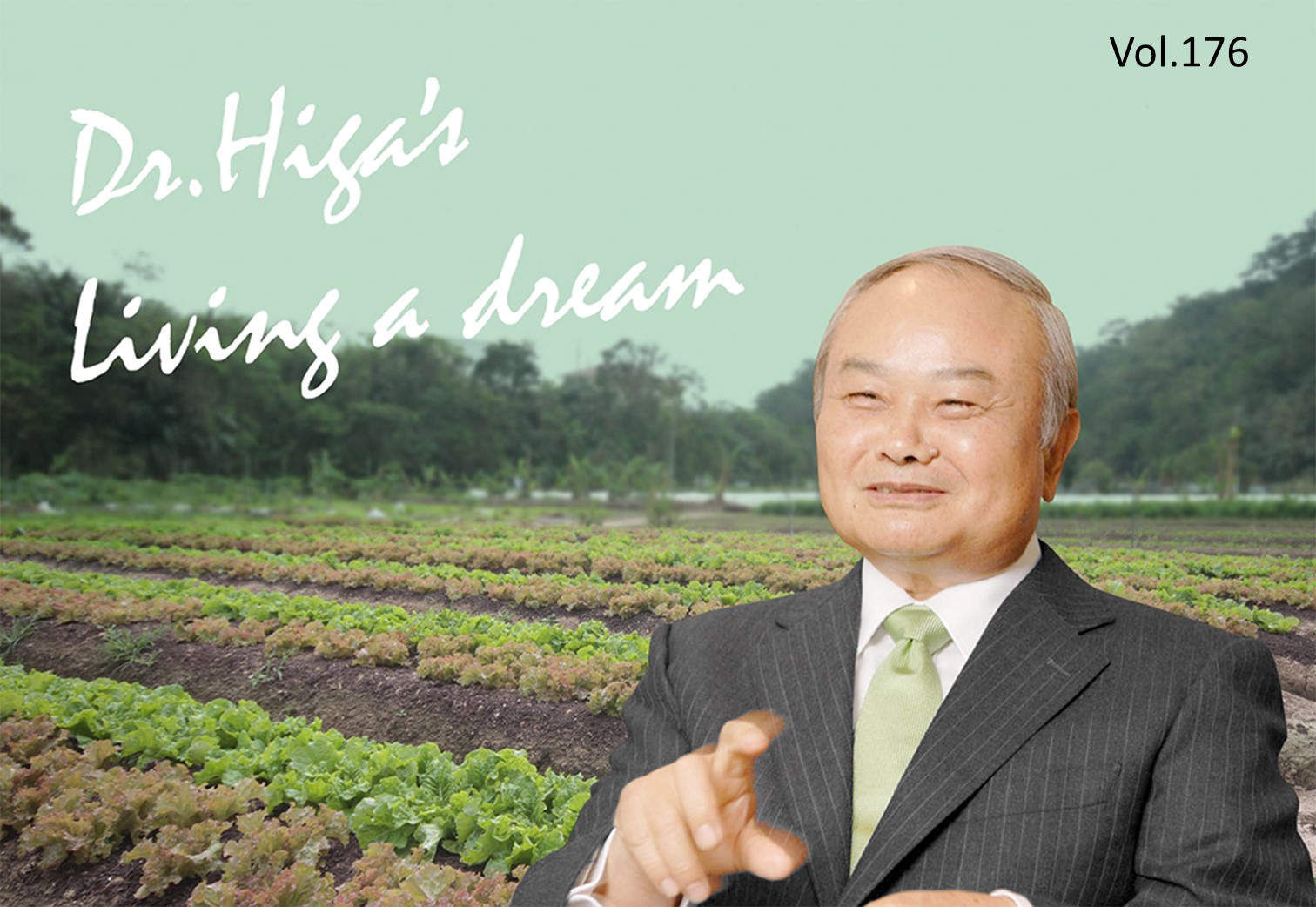
As I discussed in No. 165 of this series last year, the Gravitron Barrier on the Ryukyu Islands, which started in November 2013, has now reached a radius of 354 km throughout the entire Okinawa power grid (which currently extends 560 km to the south).
Electricity within the barrier now has photocatalytic properties, and is highly energy efficient, and there is marked decrease in salt pollution, which had been a problem on the islands. In fact, the entire Ryukyu Islands are getting cleaner year by year, with PM2.5, fine particles in the air, and exhaust gas and building pollution, having disappeared. Additionally, plants have become healthier and the natural ecosystem has gradually grown more abundant.
The rainfall has become less clustered and more like sacred water, the soil, which had been hard, has softened over the years, its water retention capacity has increased, pollution of the sea due to heavy rains has decreased, coral has revived, and large fish can now be caught along the coasts.
The Gravitron barrier has been strengthened over the years, with plant viruses beginning to disappear in 2017; since 2018 even the strongest papaya virus has completely disappeared, when the barrier was strengthened in response to the corona pandemic. Viruses are responsible for the majority of the degradation in perennial and bulbous plants such as papayas, bananas, taro, and others. Various virus-free technologies have attempted to deal with this, but the technology to eliminate viruses in natural space is unprecedented, and we are seeing the miracle of more and more virus-free plants throughout the Ryukyu Islands.
A typhoon changing its course itself is a miracle that surpasses that of plants being virus-free, and one that people may find hard to believe. However, as I have discussed in this series, the miracles brought on by the Gravitron barrier are all based on facts, and scientific verification is beginning to emerge.
As I mentioned in article No. 165 of this series regarding last year’s typhoon in 2021, the main island of Okinawa, which is located in the center of the Gravitron barrier area, was almost completely unaffected by the typhoon, and although the region was in a strong wind zone again this year, the typhoon did not cause any notable damage.
Typhoon No. 5, the first typhoon to approach the island this year, changed its course northward from Daito Island, where the Gravitron barrier is located, and passed east of Amami Oshima Island along the barrier line.
Electricity within the barrier now has photocatalytic properties, and is highly energy efficient, and there is marked decrease in salt pollution, which had been a problem on the islands. In fact, the entire Ryukyu Islands are getting cleaner year by year, with PM2.5, fine particles in the air, and exhaust gas and building pollution, having disappeared. Additionally, plants have become healthier and the natural ecosystem has gradually grown more abundant.
The rainfall has become less clustered and more like sacred water, the soil, which had been hard, has softened over the years, its water retention capacity has increased, pollution of the sea due to heavy rains has decreased, coral has revived, and large fish can now be caught along the coasts.
The Gravitron barrier has been strengthened over the years, with plant viruses beginning to disappear in 2017; since 2018 even the strongest papaya virus has completely disappeared, when the barrier was strengthened in response to the corona pandemic. Viruses are responsible for the majority of the degradation in perennial and bulbous plants such as papayas, bananas, taro, and others. Various virus-free technologies have attempted to deal with this, but the technology to eliminate viruses in natural space is unprecedented, and we are seeing the miracle of more and more virus-free plants throughout the Ryukyu Islands.
A typhoon changing its course itself is a miracle that surpasses that of plants being virus-free, and one that people may find hard to believe. However, as I have discussed in this series, the miracles brought on by the Gravitron barrier are all based on facts, and scientific verification is beginning to emerge.
As I mentioned in article No. 165 of this series regarding last year’s typhoon in 2021, the main island of Okinawa, which is located in the center of the Gravitron barrier area, was almost completely unaffected by the typhoon, and although the region was in a strong wind zone again this year, the typhoon did not cause any notable damage.
Typhoon No. 5, the first typhoon to approach the island this year, changed its course northward from Daito Island, where the Gravitron barrier is located, and passed east of Amami Oshima Island along the barrier line.
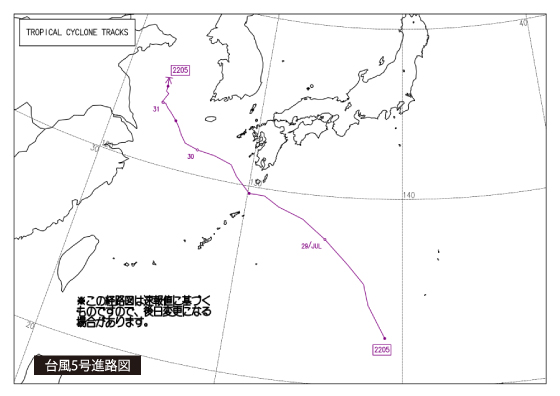
Typhoon No. 11, which struck the Ogasawara Islands in early September, was the strongest typhoon ever recorded in the summer, and was forecast to move straight westward while intensifying, hitting Daito Island and the main island of Okinawa.
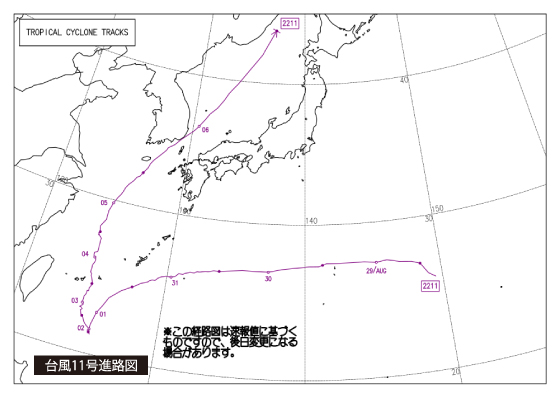
However, in reality, the typhoon moved southward along the Gravitron barrier line extending over Daito Island and eventually stalled along the boundary line of Ishigaki Island. The eye of the typhoon disappeared, then the typhoon redeveloped and moved northward, with the eye of the typhoon then reappearing.
After that, Typhoon No.12 moved slightly south of Typhoon No. 11, that is, outside the barrier line. In this case as well, the eye of the typhoon disappeared once and then reappeared at some distance from the Gravitron barrier line, a trend that appears to be getting stronger over the years.
After that, Typhoon No.12 moved slightly south of Typhoon No. 11, that is, outside the barrier line. In this case as well, the eye of the typhoon disappeared once and then reappeared at some distance from the Gravitron barrier line, a trend that appears to be getting stronger over the years.
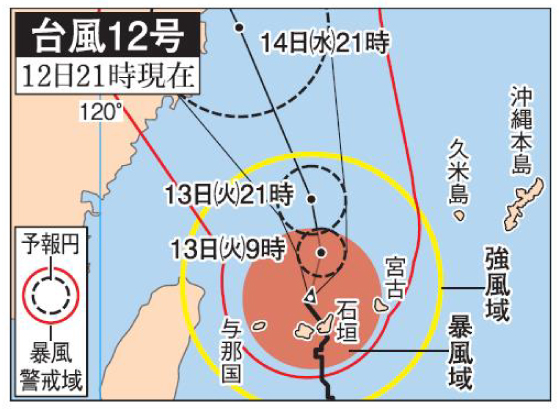
To summarize the information so far, the fact is that when typhoons cross over the boundary line, they are rectified, shock waves are reduced, and wind speeds on the east side, where typhoons are generally more intense, decrease. At the same time, they are dispersed in a tornado-shaped manner, so that damage is limited to a smaller portion of the area, making the damage considerably less than originally forecast.
Overall, the damage to aging trees and facilities is noticeable, but as a result, the level of damage is much lower than reported.
Typhoon No. 14 followed a similar track to that of Typhoon No. 5. It might seem I’m trying to turn the argument in my favor, but this typhoon also followed nearly the same track as typhoon No.10 in 2020.
Overall, the damage to aging trees and facilities is noticeable, but as a result, the level of damage is much lower than reported.
Typhoon No. 14 followed a similar track to that of Typhoon No. 5. It might seem I’m trying to turn the argument in my favor, but this typhoon also followed nearly the same track as typhoon No.10 in 2020.
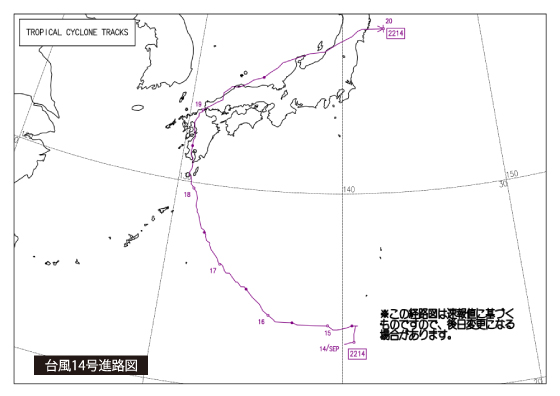
The Japan Meteorological Observatory was also planning to issue a special warning regarding Typhoon No. 10 in 2020, but the sudden weakening of the wind led them to change it to a general warning. This year’s storm conditions were similar to those of the 2020 typhoon, with partial tornado-like damage in parts and more rainfall damage than wind damage.
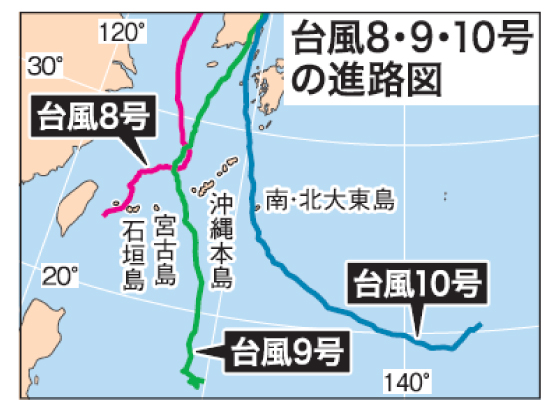
I mentioned the similarities between Typhoon No. 10 in 2020 and Typhoon No. 14 this time, and both typhoons had a fairly large and clearly formed eye at first, but they were rectified by contacting the Gravitron barrier in the Ryukyu Islands. This is quite obvious when you compare them to past typhoons that did not contact the Gravitron barrier in Okinawa and went on to strike the Kanto (Chiba) and Kansai (Osaka) regions directly, causing extensive damage there. Information from the meteorological observatory regarding this sudden change is limited, and we will await future observations. Below I will also introduce changes observed in bird behavior after the typhoon.
Information on birds in Okinawa
Information on birds in Okinawa
-----------------------------
Okinawa Times, Wednesday, September 7, 2022
Numerous wild birds after the typhoon,
Evacuating to Tarama?
On the morning of September 5th, several flocks of wild birds were observed in Tarama Village after Typhoon No. 11, a large and very powerful typhoon, had passed over. Kunio Haneji, 74, a farmer, went around the island and took pictures. Mr. Haneji, a bird lover, was surprised, commenting how he’d “never seen so many wild birds before.”
Flocks of small egrets, medium-sized egrets, cattle egrets, black stilts, and wagtails were observed standing in groups in the windbreak forests and sugarcane fields that surround the village, as if taking shelter from the wind and rain.
Mr. Haneji speculates that they may have encountered a typhoon while migrating in autumn and took refuge on Tarama Island.
Okinawa Times, Wednesday, September 7, 2022
Numerous wild birds after the typhoon,
Evacuating to Tarama?
On the morning of September 5th, several flocks of wild birds were observed in Tarama Village after Typhoon No. 11, a large and very powerful typhoon, had passed over. Kunio Haneji, 74, a farmer, went around the island and took pictures. Mr. Haneji, a bird lover, was surprised, commenting how he’d “never seen so many wild birds before.”
Flocks of small egrets, medium-sized egrets, cattle egrets, black stilts, and wagtails were observed standing in groups in the windbreak forests and sugarcane fields that surround the village, as if taking shelter from the wind and rain.
Mr. Haneji speculates that they may have encountered a typhoon while migrating in autumn and took refuge on Tarama Island.
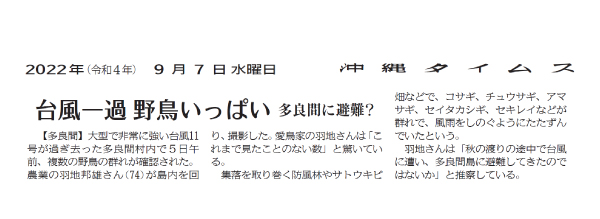
-----------------------------
Okinawa Times, Friday, September 9, 2022
A Rice Paddy Field in a Typhoon, a Traveling Bird Paradise
Taira, Nago City
On the 5th, many migratory birds were observed in Taira, which is one of the few remaining paddy fields in Nago City. On this day, Typhoon No. 11 caused strong wind and heavy rains, and the birds were seen picking food among the rice plants in the second-season crop. Many varieties of herons were observed including cattle egrets, medium-sized egrets, small egrets and Gray herons. Stilts, snipe and skylark snipes were also seen. Large flocks of more than 100 sparrows were also observed, as well as robins, wagtails, and swallows. Many of them formed flocks of various sizes, staying low as if to avoid the strong winds. When cars and people on the farm road passed nearby, they occasionally fluttered up at once in the sky, creating what looked like a waterfowl paradise. Among them, the number of black-bellied terns was particularly impressive. Mr. Yutaka Toguchi, a wildlife protection officer in the Yagaji district, said, “We often see flocks of about 10 to 20 migratory black-bellied terns, but today we counted 63. It is a rare opportunity to see so many all together. The typhoon may have changed their flight path.” They are said to fly from the Far East to Indonesia to winter there, and they disappeared the next day.
The black-bellied terns that fly to Okinawa arrive from the continent on their autumn migration when the roseate terns and black throated terns on the coast return to the south. They feed on insects and aquatic organisms, mainly in rice paddies and wetlands in inland areas, and their summer plumage includes a black head and a black or speckled pattern on the abdomen. In the observations on the 5th, only a few birds had this summer plumage, the majority of them being juvenile birds or flocks in the process of changing to winter plumage. (Reported by Jinmei Shimabukuro)
Okinawa Times, Friday, September 9, 2022
A Rice Paddy Field in a Typhoon, a Traveling Bird Paradise
Taira, Nago City
On the 5th, many migratory birds were observed in Taira, which is one of the few remaining paddy fields in Nago City. On this day, Typhoon No. 11 caused strong wind and heavy rains, and the birds were seen picking food among the rice plants in the second-season crop. Many varieties of herons were observed including cattle egrets, medium-sized egrets, small egrets and Gray herons. Stilts, snipe and skylark snipes were also seen. Large flocks of more than 100 sparrows were also observed, as well as robins, wagtails, and swallows. Many of them formed flocks of various sizes, staying low as if to avoid the strong winds. When cars and people on the farm road passed nearby, they occasionally fluttered up at once in the sky, creating what looked like a waterfowl paradise. Among them, the number of black-bellied terns was particularly impressive. Mr. Yutaka Toguchi, a wildlife protection officer in the Yagaji district, said, “We often see flocks of about 10 to 20 migratory black-bellied terns, but today we counted 63. It is a rare opportunity to see so many all together. The typhoon may have changed their flight path.” They are said to fly from the Far East to Indonesia to winter there, and they disappeared the next day.
The black-bellied terns that fly to Okinawa arrive from the continent on their autumn migration when the roseate terns and black throated terns on the coast return to the south. They feed on insects and aquatic organisms, mainly in rice paddies and wetlands in inland areas, and their summer plumage includes a black head and a black or speckled pattern on the abdomen. In the observations on the 5th, only a few birds had this summer plumage, the majority of them being juvenile birds or flocks in the process of changing to winter plumage. (Reported by Jinmei Shimabukuro)

Above: Black-bellied terns flying low in search of food in heavy rain and wind.
Below: A flock of wagtails moving in a group on the 5th, Taira, Nago City.
-----------------------------
Okinawa Times, Thursday, September 15, 2022
Flocks of herons searching for food in the fields
Kin
On September 12, a total of about 30 migratory herons, including little egrets, medium egrets and cattle egrets, and others, were observed in the rice paddies and fields near the Yaka Community Center in Kin-cho Yaka.
Little egrets were searching for food in the rice paddies, while the cattle egrets were resting on the ridges between fields and the medium egrets were busily hunting for grasshoppers and frogs in the fields.
(Reported by Manabu Tamaki)
A total of about 30 little egrets, medium egrets and cattle egrets flew in, on the 12th, in Kin-cho, Yaka.
Okinawa Times, Thursday, September 15, 2022
Flocks of herons searching for food in the fields
Kin
On September 12, a total of about 30 migratory herons, including little egrets, medium egrets and cattle egrets, and others, were observed in the rice paddies and fields near the Yaka Community Center in Kin-cho Yaka.
Little egrets were searching for food in the rice paddies, while the cattle egrets were resting on the ridges between fields and the medium egrets were busily hunting for grasshoppers and frogs in the fields.
(Reported by Manabu Tamaki)
A total of about 30 little egrets, medium egrets and cattle egrets flew in, on the 12th, in Kin-cho, Yaka.

October 12, 2022
Editor’s Picks
-

#196 The Steadily Evolving EM Nature Farming Method at the Blue Sky Palace - Part 6 -

#195 The Steadily Evolving EM Nature Farming Method at the Blue Sky Palace - Part 5 -

#191 Steadily Evolving EM Nature Farming Method at the Blue Sky Palace -

#190 Quantum Mechanical Effects of EM Gravitron Charcoal
- 2025
- Apr:#204 How EM Use Has Spread Throughout the Philippines
- Mar:#203 How to Use EM to Fundamentally Solve the Problem of Agricultural Residue Burning
- Feb:#202 The Spread of EM technology in Germany
- Jan:#201 The 2nd Ichiro Masaki Memorial Universal Village EM International Conference
- Jan:#200 Cleanup of the Ala Wai Canal in Hawaii, where social bonds are strengthened using EM
- 2024
- Nov:#199 EM trials in India with bananas, tomatoes, and pomegranates
- Oct:#198 The Steadily Evolving EM Nature Farming Method at the Blue Sky Palace - Part 8
- Sep:#197 The Steadily Evolving EM Nature Farming Method at the Blue Sky Palace - Part 7
- Aug:#196 The Steadily Evolving EM Nature Farming Method at the Blue Sky Palace - Part 6
- Jul:#195 The Steadily Evolving EM Nature Farming Method at the Blue Sky Palace - Part 5
- Jun:#194 Steadily Evolving EM Nature Farming Method at the Blue Sky Palace - Part 4
- May:#193 Steadily Evolving EM Nature Farming Method at the Blue Sky Palace - Part 3
- May:#192 Steadily Evolving EM Nature Farming Method at the Blue Sky Palace - Part 2
- Apr:#191 Steadily Evolving EM Nature Farming Method at the Blue Sky Palace
- Mar:#190 Quantum Mechanical Effects of EM Gravitron Charcoal
- Mar:#189 The barrier space in Okinawa (Ryukyu Islands) has risen to another dimension
- Jan:#188 Sixty Days after Typhoon No.6
- 2023
- Oct:#187 Supermassive Typhoon No.6 and Subsequent Typhoon No. 11
- Sep:#186 Massive Typhoon No.6 that swallowed the Ryukyu Islands Graviton barrier
- Sep:#185 August 8th is World “EM Mudball Day”
- Aug:#184 A disease-free life depends on the health of the intestinal microbiome.
- Jul:#183 Trial and Error at the Blue-Sky Palace, Part 3
- Jun:#182 Trial and Error at the Blue-Sky Palace, Part 2
- Apr:#181 Trial and Error at the Blue-Sky Palace
- Mar:#180 Ala Wai Canal Cleanup Project in Waikiki, Hawaii
- Feb:#179 High-Yield, High-Quality Rice Production Using EM
- Feb:#178 The Progress the "Soil Preparation Workshop" of the Oishi 3-chan Club (Part 2)
- Jan:#177 Organic Farming Instructional Manual Using EM
- 2022
- Nov:#176 The Typhoon Situation in Okinawa in 2022
- Sep:#175 Third-Party Verification of the Graviton barrier in Okinawa Part-2
- Sep:#174 Third-Party Verification of the Graviton barrier in Okinawa
- Aug:#173 Ecosystem Changes Observed in Okinawa in 2021 Part-5
- Jun:#172 Ecosystem Changes Observed in Okinawa in 2021 Part-4
- May:#171 Ecosystem Changes Observed in Okinawa in 2021 Part-3
- Apr:#170 Ecosystem Changes Observed in Okinawa in 2021 Part-2
- Mar:#169 Koizumi Farm in Kamakura Continues to Evolve
- Feb:#168 Ecosystem Changes Observed in Okinawa in 2021 Part-1
- 2021
- Dec:#167 Enjoying EM Technology While Enriching the Local Ecosystem
- Nov:#166 A Case Study of the Use of EM in a Next Generation Free School in Tune with the Cycles of Nature
- Oct:#165 Typhoon conditions and flowers in Okinawa from August to October
- Sep:#164 Re-learning the origins of river purification using EM Cleaning up the Dairyuji River in Senami (Murakami City, Niigata Prefecture)
- Aug:#163 Measures Against Natural Disasters and Re-learning the Starting Point of EM
- Jul:#162 Summary of FFC (Foods for Children) Okinawa Forum 2021
- Jun:#161 Restoring the Vigor of an Old Tree and Purifying the Environment with EM Technology That Even an Amateur Can Do
- May:#160 The Public is Beginning to Recognize the Use of EM Smokeless Carbonizers
- Apr:#159 EM Hado (EM Graviton) that exerts quantum superposition effect over time
- Mar:#158 Virus-free Okinawan Plants Through Use of an EM Graviton Barrier
- Jan:#157 Enjoyable Farming for Self-Sufficiency that Even Amateurs Can Do
- 2020
- Dec:#156 EM quantum energy effect occurring in Okinawa
- Nov:#155 Implementing EM graviton farming as a flood countermeasure for apple orchards
- Oct:#154 The Latest Book on the Practical Uses of EM "You Are the One Who Draws Out the Power of Microorganisms," by Chizuko Nomoto
- Sep:#153 Application of EM technology to long periods of rain, lack of sunshine, storms, heavy rains, etc.
- Aug:#152 EM application in Kitanakagusuku village plant waste recycling yard
- Jul:#151 Natural Disaster Countermeasures Using EM Technology: Part 2
- Jul:#150 Natural Disaster Countermeasures Using EM Technology
- May:#149 How to make your home and workplace an energy spot by living a complete EM lifestyle: creating the ultimate source of health and environmental purification
- Apr:#148 EM, Viruses and the Pandemic
- Apr:#147 New agriculture applying quantum mechanics Part 2
- Apr:#146 New agriculture applying quantum mechanics
- Apr:#145 Wonderful EM Miracle
- 2019
- Nov:#144 The movie “Revival II” and the reality of Fukushima
- Oct:#143 Boundary dome and foliar spraying of EM・X GOLD and EM 3
- Oct:#142 Kirakira (Sparkling) Summer Vegetable Festa in 2019
- Aug:#141 Excessive salt inevitably causes salt damage
- Jul:#140 Diverse applications of charcoal Part 3
- Jun:#139 Diverse applications of charcoal Part 2
- Jun:#138 Diverse applications of charcoal
- Jun:#137 Purification power of salt
- May:#136 The degree of soil contamination is a reflection of the microflora
- May:#135 Definitive use of EM barriers to deal with typhoons
- May:#134 Implementing authentic Nature Farming
- May:#133 How to enhance healthy Hado (wave energy) by EM
- May:#132 Eating Dirt (Soil)
- May:#131 Hado (Wave energy) involved in health
- May:#130 Reaffirming EM technology to realize the essence of agriculture
- May:#129 The 2nd EM Producer Networking Meeting
- Apr:#128 Understanding the application of seawater and salt in crop cultivation
- Apr:#127 Prevention of Disasters by EM Technology
- Mar:#126 Quantum overlay effective utilization of EM
- Jan:#125 EM Disaster Recovery Support Projects in 2017
- 2018
- 2017
- Aug:#121 Escape from conventional agricultural traps
- Jul:#120 Limitation and important caveats regarding utilization of salt
- Jun:#119 EM Technology to Break Through the Limits of Pesticide-Free Strawberries
- May:#118 Application of barriers using EM rectification force
- Apr:#117 The 1st EM Produce Growers' Networking Conference
- Mar:#116 Sumizo kun: The Ultimate Versatile Carbonization Equipment
- Feb:#115 How to make and use simple carbonized and rectified ash
- Jan:#114 Achievements of 2016
- 2016
- Dec:#113 Definitive Measures Against Typhoons
- Nov:#112 International Conference on Universal Village
- Oct:#111 90% of Your Body is Microbes
- Sep:#110 Disaster Countermeasures Using EM
- Aug:#109: Changes in the Natural Environment by EM Barrier Domes in Okinawa
- Jul:#108: Multi-purpose Utilization of Activated EM with Seawater and Salt
- Jun:#107: Marine Day, when EM Mudballs and Activated EM are Applied Throughout Japan
- May:#106: The Function of EM and Gravitational Waves–Part 3
- Apr:#105: The Function of EM and Gravitational Waves–Part 2
- Feb:#104: The Function of EM and Gravitational Waves
- Feb:#103: The Importance of Phototrophic Bacteria in EM
- 2015
- Dec:#102: Results of Environmental Forum "Utsukushima EM Paradise" 2015
- Nov:#101: Environmental Forum "Utsukushima EM Paradise" 2015
- Oct:#100: A New Phase of Limit Breakthrough Using EM
- Sep:#99: A New Phase of Limit Breakthrough through EM
- Aug:#98: The Tokyo Bay Area Began Creating a Truly Livable Hometown
- Jul:#97: Rectifying Effects of EM
- Jun:#96: Lake Suwa Sousei lecture
- May:#95: In Order to Further Ensure Limit Breakthrough
- Apr:#94: Theatrical Release of the Documentary Film SOSEI-Revival to Enlighten People on the New Possibilities of Microorganisms
- Mar:#93: What Underlies Limit Breakthrough (Part 2)
- Feb:#92: EM Functions to Break Through Limits
- Jan:#91: At the Start of 2015
- 2014
- Dec:#90: Looking Back at 2014
- Nov:#89: Shikoku EM FESTA 2014, Virtuous Circle Conference in Matsuyama, Ehime Prefecture
- Oct:#88: Using EM to Deal with Weather Disasters (Part 2)
- Sep:#87: Current Status of Radioactivity Measures Using EM in Fukushima
- Aug:#86: APNAN (Asia Pacific Natural Agriculture Network) 25th Anniversary Conference in 2014
- Jul:#85: Using EM to Deal with Weather Disasters
- Jun:#84: Substantial Improvement of Soil
- May:#83: The Energy Rectification Force of EM
- Apr:#82: The Annual 18th EM Technology Exchange Meeting and Tohoku Conference in Shichigahama
- Mar:#81: Salmon going upstream in Kitaura (Kasumigaura)
- Feb:#80: The Microbiome Again
- Jan:#79: Inauguration of the Federation of Diet Members Who Use and Apply Effective Microorganisms
- 2013
- Dec:#78: Receiving an Honorary Doctoral Degree from Rajamangala University of Technology in Thailand
- Nov:#77: The Use of EM in School Education in Bhutan
- Oct:#76: Well of Bonding
- Sep:#75: The Background to EM Not Being Employed by Public Institutions to Deal with Radiation
- Aug:#74: Dealing with Disaster: Using EM in Crisis Management
- Jul:#73: EM Events on Ocean Day
- Jun:#72: Using EM to Deal With Heat Stroke and Summer Heat Fatigue
- May:#71: An EM Model Town in Malaysia
- Apr:#70: Steps the Japanese Government is Taking to Deal with Radiation: Are They Really Safe?
- Mar:#69: EM Group Disaster Reconstruction Aid Project in Fukushima
- Feb:#68: EM and Microbiomes (Microbial Flora)
- Jan:#67: A Necessary Evil is Still Evil
- 2012
- Dec:#66: The 17th National EM Technology Exchange Conference / Hokkaido Conference in Sapporo
- Nov:#65: EM Forum 2012 in Okinawa and the Environmental Forum in Fukushima
- Oct:#64: 2012 EM Forum
- Sep:#63: A New Earth Saving Revolution
- Aug:#62: The Asahi Newspaper’s Misguided Reports About EM
- Jul:#61: Using EM in Radioactive Contamination Measures in Fukushima Prefecture
- Jun:#60: The Effects of Using EM to Inhibit the Absorption of Radioactivity as Confirmed in Fukushima
- May:#59: Recovery Support for the Great East Japan Earthquake
- Apr:#58: The Royal Kingdom of Thailand, in which EM Functions as a Set Government Policy
- Mar:#57: Report on the Measures Taken by Kingdom of Thailand Using EM to Deal with Polluted Water
- Feb:#56 EM™ as Part of National Policy in Thailand to Deal with Sanitation Issues Resulting from the Flood of 2011
- Jan:#55 The Law of Syntropy (Revitalization)
- 2011
- Dec:#54 EM Forum 2011
- Nov:#53 Shikoku EM Festa 2011- Zenjunkan no Wa (Virtuous Circle) Tokushima Conference in Naruto -
- Oct:#52 The Mystery of Interim Safety Values for Radioactive Material
- Sep:#51 Successful Radiation Countermeasures Using EM
- Aug:#50 Events on Sea Day in which EM Mud Balls are Thrown into the Water and Activated EM is Applied.
- May:#47 Dealing with the Damage Caused by the Eastern Japan Earthquake
- Apr:#46 Eastern Japan Earthquake
- Mar:#45 The 16th National EM Technology Hokuriku Conference in Fukui
- Feb:#44 More Thoughts on Avian Influenza and Foot-and-Mouth Disease
- Jan:#43 Happy New Year!
- 2010
- Dec:#42 Shikoku EM FESTA 2010・Zenjunkan no wa (Virtuous Circle) Fellowship Conference in Tobe, Ehime Prefecture
- Nov:#41 EM Forum 2010
- Oct:#40: My Thanks to the EM™ Volunteers Who Helped in the Fight Against Foot-and-Mouth Disease in Miyazaki Prefecture
- Sep:#39 International EM Mud Ball Day
- Jul:#37 Poland EM Forum 2010
- Jun:#36 EM Countermeasures Against Foot-and-Mouth Disease
- May:#35 Abnormal Weather
- Apr:#34 EM Activities in Thailand: Finding Solutions to the Challenges Facing the Nation
- Mar:#33 New Developments in the Evolution of EMTM in Thailand
- Feb:#32 Results Starting to Be Seen at the Mikasa Project
- Jan:#31 Towards an EM-Use Society
- 2009
- Dec:#30 EM Summit
- Nov:#29 The System in Penang State in Malaysia that Made the World EMTM Mudball Day a Success
- Oct:#28 The "World EM Mudball Day" in Malaysia
- Sep:#27 Validating EMTM Medicine: Case Study Reports from EM Users 2009. (Part 3)
- Sep:#26 Validating EMTM Medicine: Case Study Reports from EMTM Users 2009. (Part 2)
- Jul:#25 Validating EMTM Medicine: Case Study Reports from EMTM Users 2009. (Part 1)
- Jun:#24 Activities to Disseminate EM-Focused Nature Farming in China
- May:#23 Use of EMTM in Response to Swine Flu
- Apr:#22 Using EM to Solve Public Administrative Costs
- Mar:#21 Reaffirming the Versatility of EM
- Jan:#20 The Beginning of a New Era
- 2008
